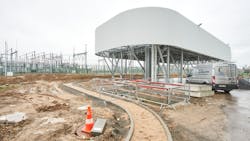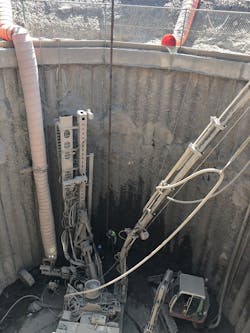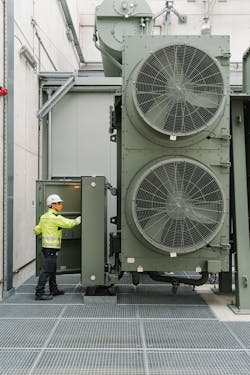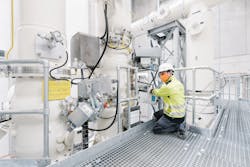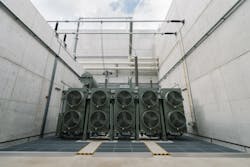Interconnector Brings Flexibility To European Market
Announced at the end of 2019, the European Green Deal aims to ensure Europe becomes the world’s first climate-neutral continent by 2050. As part of the deal, the European Commission presented its EU strategy for energy system integration in 2020, outlining its plans to establish an integrated energy system that will support the continent’s decarbonization and greenhouse gas (GHG) emission reduction targets. Commissioned in November 2020, the Aachen Liège Electricity Grid Overlay (ALEGrO) interconnector linking Belgium to Germany forms an important part of this future system.
The 1-GW high-voltage direct current (HVDC) interconnector was recognized by the European Commission as a Project of Common Interest in 2017. Research undertaken in preparation for the construction of the interconnector was supported by funding from the European Commission’s Trans-European Networks for Energy (TEN-E) program, part of the TEN-E policy, which focuses on linking up the energy infrastructure of EU member states.
Interconnector Route
Based on a feasibility study assessing the different routes the interconnector could follow, Elia Group decided to build the interconnector underground, given it would be crossing highly populated areas on either side of the Belgium-Germany border and could closely follow preexisting railway and motorway routes. Direct current (dc) was chosen over alternating current (ac) because HVDC technology offers a wide range of active power control functionalities and additional ancillary services, and it does not require any reactive power compensation.
The ALEGrO interconnector is 90 km (59.9 miles) long, 49 km (34.4 miles) of which runs through Belgian soil. It stretches from the Lixhe converter station in Belgium to the Oberzier substation in Germany, mainly by running alongside existing infrastructure such as motorways, high-speed railways and waterways. From Lixhe in Belgium, it runs south along the Albert Canal towpath and then eastward from Herstal, along the E40 motorway followed by a railway, before crossing into Germany. From there, it follows the A44 and 14 motorways for 41 km (25.5 miles), mainly across farming land, to the converter station in Oberzier.
Phased Construction
On the Belgian side, the construction of the interconnector involved three main phases. From 2013 to 2016, Elia worked on proposed revisions to the zoning plan for Wallonia, a regulatory tool for land use and regional planning. The proposed changes, including the converter station in Lixhe and the corridor where the cables would be laid, were sent to the 14 municipal authorities that would be affected by ALEGrO. Having secured approval for these changes in 2016, Elia sought permits for the work to be undertaken, which were granted in late 2017. Finally, construction work began in January 2018 on three parts of the project at once: the converter station; the micro-tunnel, which needed to be built under the Albert Canal and Meuse River; and the laying of the interconnector cables.
Converter Stations
Two converter stations, built by Siemens Energy and located in Lixhe and Oberzier, respectively, convert ac from the Belgian and German grids into dc, so it can be transported across the interconnector. The converter station in Lixhe, Belgium, took two years to build and is 123 m long by 20 m high by 82 m wide (404 ft by 66 ft by 269 ft). It was designed to be optimally integrated into the surrounding environment.
At the Lixhe converter station, ac from the Belgian grid first enters a gas-insulated switchgear room before the electricity is converted into dc. The electrical current then flows through transformers that ensure a constant level of voltage is maintained. Following this, the voltage source converter transforms the ac into dc, which is then transmitted through the interconnector cables. The modular multilevel converter is built in a half-bridge arrangement. This compact piece of converter technology enables grid operators to manually set exactly how much power needs to be transferred in either direction. It has a reactive power of ±300 MVAR maximum when active power transmission is enabled. In static synchronous compensator (STATCOM) operations, up to ±500 MVAR can be provided to the ac connection point. The converter also can react to voltage fluctuations in less than one thousandth of a second, meaning it can be used to help stabilize the electricity network.
Cable Systems
The interconnector is a point-to-point symmetrical monopole connection that comprises two 320-kV, 2500-sq mm (3.9-sq inches) HVDC crossed-link polyethylene (XLPE) copper cables with a diameter of 120 mm (4.7 inches) each. Separate engineering, procurement and construction contracts were awarded to General Cable (now part of Prysmian Group) by Elia and Amprion for the work in Belgium and Germany, respectively. General Cable was responsible for the design, engineering, production, installation and commissioning of the complete HVDC cabling system, including civil works and construction of the micro-tunnel in Belgium.
Cable sections were laid across the entire route, with a total of 84 cable joints connecting each of these sections together. The cable sections were laid in trenches of 1.8 m deep by 1 m wide (5.9 ft by 3.3 ft), with each section taking approximately six weeks to finish. More than 30 instances of horizontal directional drilling were carried out along the Belgian section of the route. This was the first time cable installation as part of Elia projects were performed along Belgian motorways, requiring
attention to safety.
On the German side, three micro-tunnels — with a combined length of 4.5 km (2.8 miles) — were built so the interconnector could cross residential and commercial areas. Eight sections were built using horizontal directional drilling, so the interconnector could cross existing infrastructure and environmentally sensitive areas. ALEGrO has a rating of 1050 MW, the equivalent of 1/14 of Belgium’s average electricity consumption. At nominal power, the interconnector’s losses amount to 2%, with 1.6% of this caused by the two converters and 0.4% caused by cable losses.
Micro-Tunnel In Belgium
At the Cheratte viaduct in Herstal, the Elia team had to build a micro-tunnel under the Albert Canal and the Meuse River. The construction of this tunnel — located 30 m (98 ft) underground, a depth required to reach a homogeneous layer for the micro-drilling, and 670 m long by 2 m in diameter (2198 ft by 6.6 ft) — involved state-of-the-art techniques. A drilling machine was used to do the directional drilling for the horizontal part, while micro-piling techniques were used to excavate and construct the two access pits to the tunnel.
Commercial Operation
Capacities for cross-border trading were released in stages: the first capacity was made available to the market via a day-ahead allocation mechanism on Nov. 18, 2020. This was followed by intraday capacity trading in December 2020, and monthly long-term capacity trading in early 2021. Annual long-term capacity trading opened in 2022.
In its first year of operation, from Nov. 18, 2020, to Nov. 18, 2021, ALEGrO proved to be a reliable asset, as it was available for market/trading 93% of the time. A total of 4.3 TWh of electricity was exchanged, with 45% of the day-ahead flows across ALEGrO being directed from Belgium to Germany and 55% of the day-ahead flows being directed from Germany to Belgium. An average of 700 MW was exchanged between both countries when there was a price difference. During its second year of operation, ALEGrO was available for market/trading 98% of the time and 5.07 TWh of electricity was exchanged.
Evolved Flow-Based Approach
The interconnector’s location in the center of the meshed ac European grid was challenging, particularly when compared with other interconnectors positioned along the edges of the European continental synchronous ac system, such as Nemo Link. The latter, which links Belgium to Great Britain, has a relatively low impact on the rest of the European grid because of its location. On the other hand, ALEGrO needed to be used in such a way that considered congestion in other parts of the ac grid and would not cause overloads in the grids of connected and neighboring transmission system operators (TSOs). Therefore, ensuring the grid could be securely operated meant the possible tripping of the interconnector (and its redistributive effects on the ac grid) also needed to be considered. Given the day-ahead market is the most significant market time frame in terms of the volume of energy traded, use of the interconnector and its operation in this time frame was the focus of the project.
As part of the EFB approach, no ex-ante assumptions about the direction or magnitude of the flow of energy across the interconnector are taken. Instead, the set point of ALEGrO — the optimal flow of energy across the interconnector regarding the distribution of energy flows in the CORE region — is defined as a variable in the market coupling algorithm, thus considering the impact of cross-border exchanges on different critical grid elements. As a fully controllable dc device, ALEGrO is used to steer the flows of energy or distribute them in the most efficient way between itself and the rest of the ac grid, in such a way that congestion is minimized and prices for consumers optimized.
The adoption of the EFB approach means nonintuitive flows may occur; this happens when the market coupling algorithm determines the most optimal flow across the interconnector is from one country experiencing high energy prices to the other country experiencing low prices. Such nonintuitive flows relieve congestion on other critical elements across the ac grid and enable cross-border exchanges to be maximized through other paths of it, with the aim of maximizing the value (or socioeconomic welfare) created by market coupling.
Strong collaboration and regular communication between Elia, Amprion and the neighboring TSOs of TenneT in the Netherlands and RTE in France were essential for the adoption and success of the EFB approach. Additionally, numerous phases of testing and simulations of the EFB approach with ALEGrO were undertaken. Over a six-month period, before the interconnector was commissioned, the results of daily simulations of the grid with the existence of ALEGrO were compared with the actual operation of the grid without it. During this time, Elia and Amprion published the results of capacity calculation and market coupling processes as if ALEGrO were already in operation. These simulations, launched in May 2020, suggested almost €100 million of socioeconomic welfare could be generated for consumers and producers across the CWE region.
The EFB approach was successfully implemented once ALEGrO was commissioned in November 2020, constituting a first step toward including flexibility in the interconnected European market for electricity. The approach has demonstrated controllable devices such as HVDC interconnectors can be optimized.
Maximum Flexibility
The ALEGrO interconnector was built to efficiently enhance Belgium’s and Germany’s security of supply, facilitate the integration of renewable energy into the electricity grid and contribute to price convergence. From the very beginning, Elia and Amprion — the Belgian and German TSOs, respectively, that built the interconnector — were aiming to ensure ALEGrO could offer maximum flexibility to the market, especially in the day-ahead time frame.
Given its location in the middle of the European meshed ac grid and its use of dc technology, the EFB methodology was adopted for the first time, meaning exchanges between Belgium and Germany and across the entire CWE capacity calculation region could be optimized.
Helen Burgess ([email protected]) is a researcher and copywriter who works for the external communications team at Elia Group. She is from London and
is currently based in Brussels, Belgium.
About the Author
Helen Burgess
Helen Burgess ([email protected]) is a researcher and copywriter who works for the external communications team at Elia Group. She is from London and is currently based in Brussels, Belgium.
